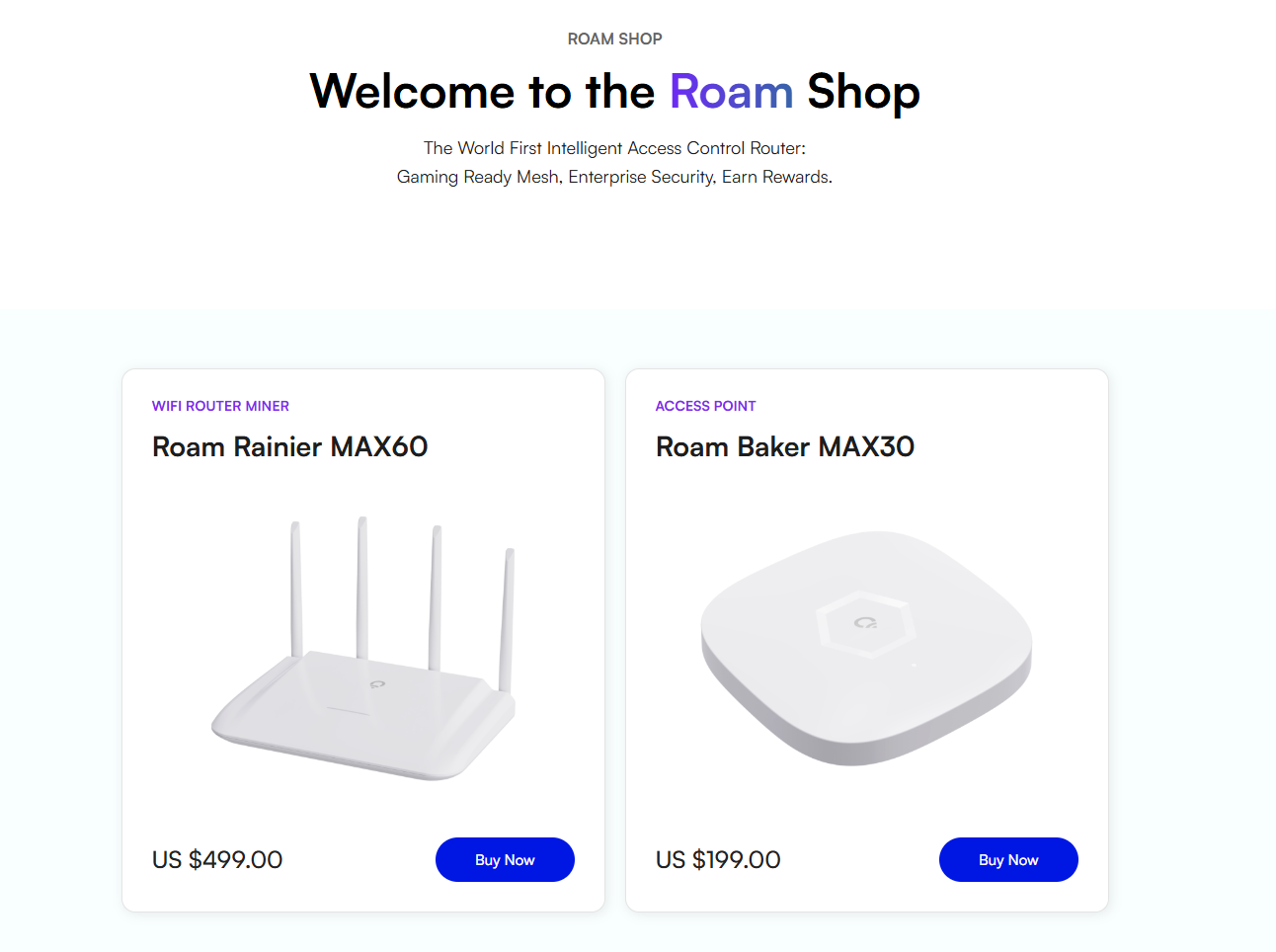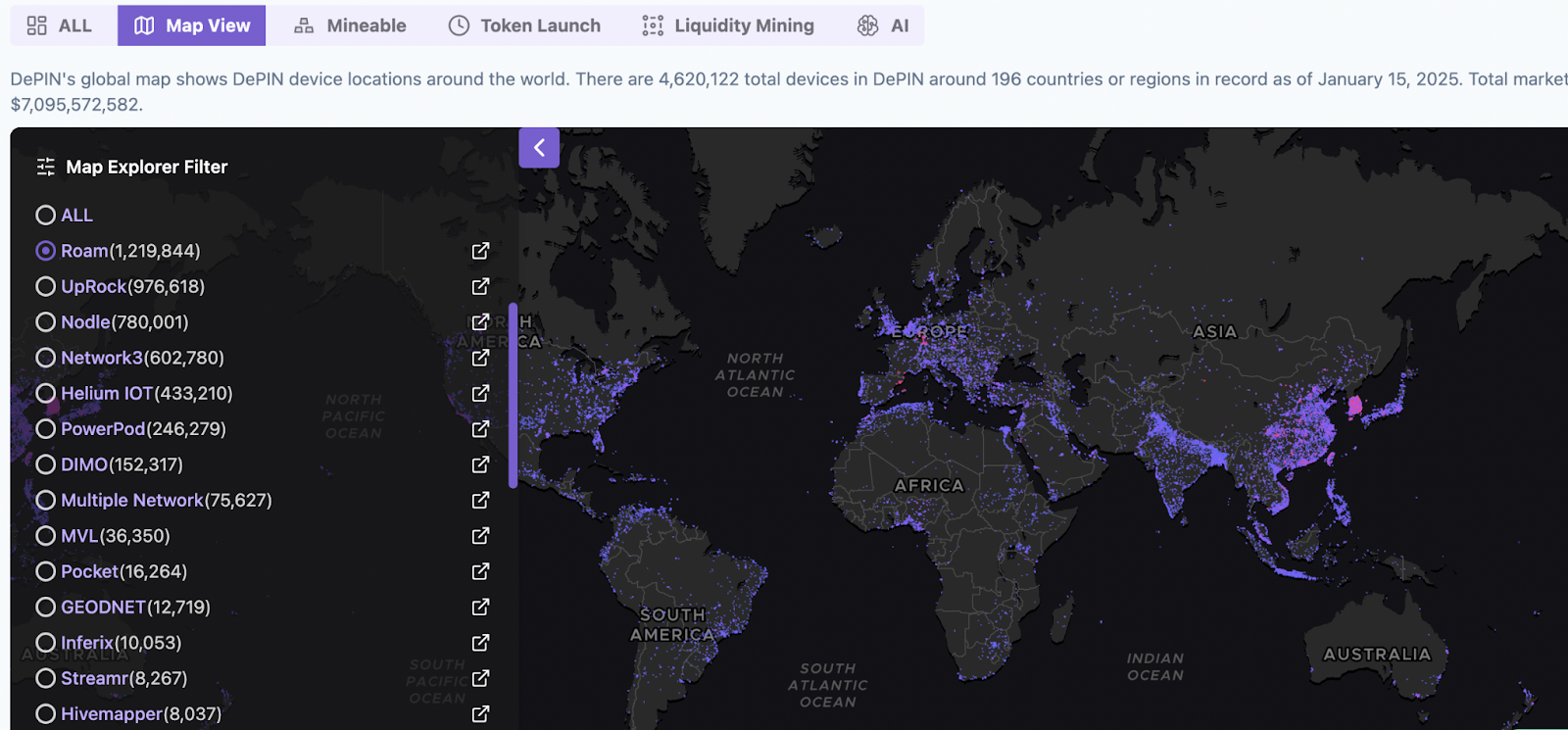Solana officially promotes DePIN project Roam: with millions of nodes, South Korea has become a "mining" center

Reprinted from panewslab
01/15/2025·22days agoAuthor: Frank, PANews
On January 14, Solana’s official Twitter recommended Roam, a DePIN project, and introduced that Roam is unifying more than 1 million WiFi hotspots onto the Solana network. However, there have not been many previous introductions to Roam in the encryption field.
According to data from DePINscan, the current total number of Roam devices is approximately 1.21 million, ranking first in the world. What is the “magic” behind this rapid growth? Can its core model - "low-threshold router mining + token incentives" really support the global expansion of roaming WiFi networks?
Low-threshold router + token expected to attract millions of nodes
Roam was founded in 2021. So far, it has completed two rounds of financing totaling US$7 million (a seed round of US$2 million and a strategic financing of US$5 million). As a DePIN project, compared to major financing players such as IoTeX, io.net or Helium, Roam can be regarded as "spending small money to do big things" in terms of financing amount. The reason for achieving this effect may be related to Roam’s business model.
Roam is a decentralized WiFi network operator whose main goal is to create a global decentralized WiFi roaming network. The narrative is relatively simple. Users can contribute their own WiFi to join the Roam network. If other users connect to the WiFi, the users who contributed to the network can obtain corresponding reward points. These reward points can in turn be exchanged for ROAM tokens.
In the research, PANews found that in July 2024, the number of registered users and devices of Roam was only more than 400,000. In just 7 months, the number of devices increased by 800,000 to 1.21 million. According to DePINscan data, The number of devices ranks first in the world, and the total number of registered users has reached 2.08 million.
In addition to adding personal routers to the Roam network, Roam's economic mechanism also designs a self-operated device for WiFi miners. By purchasing Roam's official router, users can obtain additional rewards in addition to the basic rewards and an NFT. Rewards, such as an extra 60 points per day, or up to 150 points when a user logs in. Currently, Roam has launched two routers: MAX30 (priced at US$199) and MAX60 (priced at US$499). However, judging from the introduction, only MAX60 users can enjoy additional point rewards. Except for extra points rewards and NFT, there seems to be nothing particularly innovative about the performance of these two routers. The average price of equipment with the same performance as the MAX30 produced by a domestic technology brand is less than 300 yuan, a price difference of more than 5 times.

In this narrative, the reason why Roam was able to quickly gain more than 1 million users may be because routers are currently the most common household devices and have no special performance requirements and do not require excessive settings or participation. The threshold is lower.
When PANews observed Roam's network distribution, it was found that Roam's device density is the highest in South Korea, covering almost the entire region. Secondly, it is relatively dense in China, Southeast Asia, Europe and other regions. The equipment density in the United States is not very high. Judging from these distributions, the main coverage areas are also concentrated in areas with developed networks, while equipment coverage in underdeveloped areas such as Africa is very low. Roam currently covers more than 140 countries.

Can high-premium router mining obtain excess returns?
According to the official introduction, the total amount of ROAM tokens is 1 billion, 400 million will be generated by TGE activities, and the remaining 600 million will be mined later. Among the 400 million coins generated by TGE, 280 million coins are used for sales and 120 million coins are reserved for the team. In September 2024, it was officially announced that 20 million tokens would be issued as airdrops to MAX60, MAX30 and NFT owners as well as previous Roam OG miners at the time of TGE.
As of January 15, the number of points issued by Roam was approximately 2.139 billion, but the exact ratio of points to ROAM tokens has not yet been determined, and the specific TGE time has not been announced.
However, we can make some simple estimates. The circulating market value of IOTX tokens, another DePIN project that has raised US$85 million, is currently approximately US$330 million, and the market value of Helium's token HNT is approximately US$867 million. If the initial circulation market value of ROAM tokens after issuance can reach the market value of IOTX, the average price of each ROAM token will be approximately US$0.825, and its airdrop size will be approximately US$16.5 million. The currently officially announced registered users are 2.09 million, with an average of The user's points are about 1023, and the average amount each user can get is about 7.8 US dollars. Assuming that half of the 1.21 million nodes are users who have purchased equipment, then the average airdrop each user of 600,000 users who purchased equipment can receive is approximately $27.
Assuming that the official uses all the 280 million tokens for sale in TGE to redeem points, based on the current amount of points issued, the exchange ratio of points to tokens is about 7.6:1. If its market value reaches IOTX level, then the value of each point is approximately 0.1 US dollars, based on the points awarded to users who purchase the equipment, you can get 3,000 points as a reward for purchasing the equipment, plus a 60-point reward every day for 100 days after it is turned on. If the total points reach 9,000 points, the total revenue may reach $900. However, this situation is the most ideal state, because the above calculation method estimates two extreme methods, but it should also have certain reference significance. The average airdrop size may range from $7.80 to $900. For users who purchase equipment, if they only get a return of $900, plus 100 days, this investment-output ratio does not seem to be high.
According to Roam officials, if half of the devices are exclusive routers purchased by users, then the revenue from this part can reach at least US$127 million. Even if only one-tenth of the equipment were dedicated routers, this revenue would reach at least $25.47 million. From this perspective, Roam’s equipment revenue may make it the biggest winner in this airdrop narrative.
In addition to decentralized WiFi networks and token pegs, Roam has also launched international roaming network service eSIM. According to official reports, Roam’s eSIM service currently covers 160 countries and regions. This eSIM is similar to the international roaming network services launched by telecom operators that we are familiar with. In terms of pricing, the pricing ranges from US$1.19 to US$1.99 per 1GB. The price of this service is higher than the roaming service price of telecom operators in mainland China.
Roam has become a new force that cannot be ignored in the DePIN circuit. Compared with many projects that frequently raise hundreds of millions of dollars in financing, Roam has achieved the effect of "spending little money to do big things" with only $7 million. However, as far as the current coverage areas are concerned, Roam's coverage areas are all areas with developed networks. The demand for WiFi in these areas does not seem to be a rigid need. The current device access is mainly due to the expectation of token incentives. For Roam officials, what kind of planning for the next token economy may be the biggest challenge. If the airdrop effect is not as expected, a large number of shutdowns may occur. In addition, will the current number of nodes be maintained after the airdrop and will there be an incentive to attract more nodes to connect? It is also an issue that cannot be ignored before Roam. ****


 jinse
jinse
 chaincatcher
chaincatcher